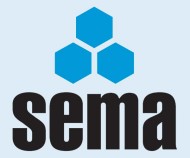 This month we bring you two enquiries, the first regarding what, if any is the permitted lateral movement in Racking? and the second query about modifications that can be made to racking.
This month we bring you two enquiries, the first regarding what, if any is the permitted lateral movement in Racking? and the second query about modifications that can be made to racking.
Lateral Movement in Single Bay Racking
Q. During a recent visit to a client it was drawn to my attention that, when not loaded with goods, a five bay run of single depth racking could be moved laterally by exerting physical effort against the end upright, resulting in about six inches of lateral movement at the top of the uprights. The racking is in good condition, showing no visible signs of damage. All uprights are bolted to the warehouse floor and the beam connector locks and cross bracings are all in place. Is there a permitted/recommended amount of movement? Should the client be considering attaching the racking to the building structure with wall ties?
A. There is no limitation in any of the racking design codes limiting the kind of movement that you describe on an empty rack. However, it is most unusual to observe movement of this magnitude once the racking has been through a few cycles of loading and unloading so that the beam connector lugs bottom out in their support pockets.
If there is only a single beam level in the height this does sometimes cause movement and indeed some manufacturers will reduce the normal permitted load on an end frame or pair of beams to allow for this effect when used in such a ‘goalpost’ situation.
It is rather basic however if it has not already been done, we would recommend that you check that the beams concerned are supplied by the same manufacturer as the upright frames, such that the connectors on the end of the beams are in fact designed to fit in the pockets of the uprights.
If all of the above appears to be in order we would suggest that you make contact with the racking supplier or the manufacturer and seek their advice. Most suppliers will be prepared to visit site and confirm that there are no problems and that the system is safe to continue to use.
Conveyors Running through the End Frames of Racking
Q. We have a consultant who wants to put conveyors through racking frames under picking locations (left to right) in say 30m runs. The position would mean moving the cross braces or even having special frames made for this application and we would have thought it made more sense to have the conveyor stand in front of the Pallet Racking with the live storage beds protruding? What are your thoughts on this?
A. It is not unusual for conveyors to be specified through the end frames of a rack though this is usually expensive and certainly involves some serious calculation work and some extra steel to replace the stiffness provided by the frame bracings that have to be removed.
We see no reason why the conveyor could not be run in the front of the upright with picking trays cantilevering over the conveyor as you describe. The downside which of course there always is, would be that the cantilever would ensure that the front upright was heavily loaded and either the rear would have to have a similar cantilever to provide balance or a much stronger front upright might be required and /or extra bracing would be required to resist the overturning forces and extra vertical load on the front upright.
Some serious uplift forces could be present in the rear upright assuming that all the cantilever parts of the trays were fully loaded and all the remainder of the storage trays were empty. This may be unlikely but it is a load case that would have to be considered in the design as this would result in the entire load being forward of the front frame upright which is an unbalanced load situation.
We suspect that the rack would look a little like a Christmas tree from the end which does not sit well with our perspective of how a rack should look.
Sorry we cannot be more definite however the basic principal should work with a bit of thought and careful engineering. It is probably worth having the two alternatives costed to see which comes out the more cost effective.
SEMA Technical Enquiries: We hope you find the above articles, and those in previous editions, interesting. If you have a query send it to us by fax or email and we will do our best to have it answered by one of our technical experts.
SEMA Rack Safety Awareness and Inspection Courses: SEMA runs a one-day safety course on Rack Safety Awareness and Inspection. These courses are aimed at end users, giving an in-depth look at the need for inspections, how to conduct an assessment and what actions to take when this is completed. These courses are normally held at the SEMA headquarters but arrangements can be made to hold them at the delegates’ premises.
SEMA Approved Rack Inspectors Qualification: This qualification is aimed at professionals who conduct rack surveys as an integral and significant part of their duties. It involves delegates in undertaking an in-depth SEMA Course, together with an examination and practical assessment. CPD will be an important part of the qualification, demonstrating to end users that SEMA Approved Inspectors maintain a high professional standard.
SEMA
Tel: 0121 601 6350




Comments are closed.